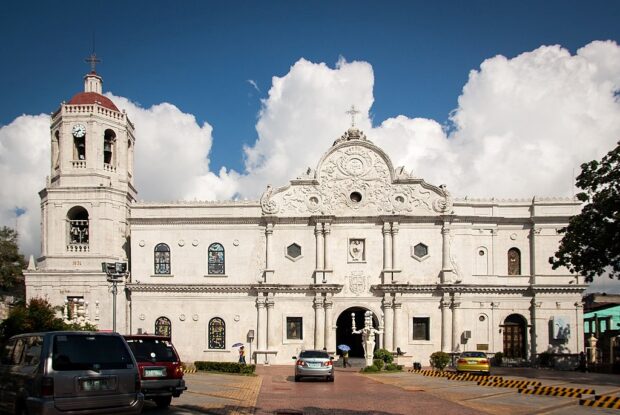Group of priests bucks split of Cebu archdiocese

ARCHDIOCESAN SEAT The Cebu Metropolitan Cathedral, also known as the Metropolitan Cathedral of the Holy Angels and of St. Vitalis, is the ecclesiastical seat of the Metropolitan Archdiocese of Cebu based in Cebu City. Moves to divide the archdiocese into three face opposition from some priests. —ARNOLD CARL FERNAN SANCOVER/CONTRIBUTOR
CEBU CITY—Some members of the Cebu clergy have expressed concerns over moves to split the biggest archdiocese in the country into three.
In a position paper presented to Cebu Archbishop Jose Palma in September, some priests expressed apprehension over the proposed “Sugbuswak,” a word derived from “Cebu” and “buswak,” relating to the Cebu archdiocese’s readiness to blossom like a flower.
“Sugbuswak is consequential to the future of the Cebuano clergy. When that happens, a big part of our priesthood will never be the same again. Since such historic change will affect our hearts and minds, then the same hearts and minds shall be able to participate in the process of making such a decision,” said the position paper signed by Fr. Michael Raypan, a copy of which was obtained by the Inquirer on Sunday.
It added: “We are deeply concerned about Sugbuswak. And we believe that it is the yearning of each and every Cebuano clergy to own such historic decisions since it involves our life, our future, our priesthood.”
According to Raypan, who presented the position paper to Palma, the apprehension came from a group of priests age 50 to 55, the specific number of whom he did not reveal.
These priests believed there was no need for a split since the Cebu archdiocese had been able to effectively manage its current population, said Raypan, the parish priest of St. Raphael the Archangel Parish Church in Aloguinsan town.
“The increase in the number of parishioners and clerics shall be seen as a welcome blessing and shall not be regarded as an administrative nightmare. So we think that there is no compelling reason to divide or break up the archdiocese,” the priests said.
At present, the Cebu archdiocese has at least 176 parishes, more than 400 diocesan priests and around 225 religious priests serving at least 3.8 million lay Catholics in Cebu, dubbed the “cradle of Christianity in the Far East.”
To be closer to the flock
If the Sugbuswak was approved by the Vatican, the Archdiocese of Cebu will be reduced to a smaller church while two dioceses—North Cebu and South Cebu—will be created.
Palma will lead the Cebu archdiocese while two bishops will be appointed by the Pope to shepherd the two dioceses.
The prelate earlier explained the church’s resolve to split the Archdiocese of Cebu to serve more people in far-flung areas.
Palma believed that dividing the archdiocese would benefit both the priests and the people.
He cited instances when he had to travel for several hours just to reach a church in remote areas of Cebu.
In the same way, Palma said priests or laypeople, who wanted to raise some concerns, spent so much time in order to visit him at the Archbishop’s Residence in Cebu City.
“If someone would invite me for Mass [in the province], I usually leave the city, say around 6:30 a.m., and I arrive around 10 a.m. Then we have lunch, talk for a short while with the priests and laypeople, then I go back home,” Palma said.
“Also, if people need to see me, how long would it take them to reach me here? I pity them,” he added.
Palma said having new dioceses would bring the bishop closer to its people.
History, culture
But the group of priests said the local church should take into account the historical value of a single unit, aside from the problems the split may create, such as the uncertainty of resources and the demographics that are dwindling and aging.
“Our history and culture as a Cebuano are closely connected with our religion. Cebu as one is called the Cradle of Christian Civilization in the Far East and that heritage has shaped our unique identity as ‘Sugbuanon nga Simbahan.’ We are uniquely Cebu and we are different from other provinces and dioceses,” they said.
“On account of this, do we need to copy or replicate preceding divisions? The Archdiocese of Cebu has 500 years of history. She is a heritage that has stood the test of five centuries. If we are so careful about preserving edifices with historical value, can we not give the same care and respect to the archdiocese?” they added.
The archdiocese, the priests said, is a contiguous island and this geographic nature presents an inherent difficulty in dividing it as an archdiocese or even as a province.
Such contiguity, they said, had greatly influenced even the Cebuano language: “We are one province, one archdiocese that speaks only one dialect, Cebuano, unlike the island of Negros where the Orientals speak Bisaya and the Occidentals Hiligaynon.”
“Another case in point is the island of Leyte where the Southerners speak Bisaya and the Northerners Waray-Waray. This contiguity has even influenced our deep sense of solidarity that in times of calamity what happens in one part affects the entire province. Dividing the [Cebu] archdiocese, therefore, is like surgically separating conjoined twins who share one and the same beating heart,” the priests said.
They hoped that Palma and other officials of the church would not decide on the Sugbuswak in haste.
“The process of understanding necessitates engagement. Hence, it is our prayer that we may be given ample time to reflect on the pros and cons of Sugbuswak. It is also our hope that a parallel study be made on the benefits and drawbacks of keeping the Archdiocese of Cebu as one. Allow us to have a free discussion in our districts and challenge us to ask the hard and difficult questions that the variables may be seen and understood,” the priests said. INQ